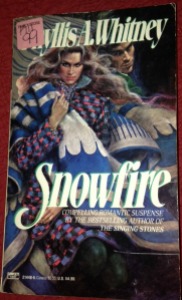 The Landower Legacy
The Landower Legacyby Victoria Holt
Publication Date: March 14, 1984
Genre: gothic romance, romance
Pages: 373
Green-eyed Caroline Tressidor has everything: beauty, a title, an inheritance -- and a secret that can destroy it all. Determined to discover the truth, Caroline begins a search that will take her from London to the wild moors of Cornwall . . . and into the arms of the mysterious Paul Landower, a man whose past may include a legacy of murder . . .
This one is hard for me to review, because it was not a bad read, but it absolutely did not live up to the promise of the genre/cover synopsis. I can’t really characterize this book as gothic, as there was almost no suspense at all. If I were pressed to put a genre on this book, cover and description nothwithstanding, it would probably be historical romance, or maybe family drama. I’m not really sure.
So, let’s get to my complaints. When I read a gothic romance, I am expecting that the heroine will be put in significant danger by someone who wants to keep her from succeeding in attracting the hero. There might also be some perceived light supernatural elements, even if it turns out at the end that they were just plain old human avariciousness or jealousy. A bit of haunting perhaps, or some lights appearing and disappearing in the woods. That sort of thing.
There should also be a secret that is coming back to haunt someone – usually the Hero. And then, last but certainly not least, there should be some sort of a large country home or chateau that is the center of all of the action.
So, with this book, all of the elements were here: a haunted mine shaft where black dogs appear when someone is in danger, an impoverished hero who is trying to save the estate that has been in family since the 15th century, and a number of secrets possessed by a number of characters.
The problem with the book is that none of these three things really had anything to do with each other. I am accustomed to seeing them used as plot devices, but their disconnection from one other made them just that much more obviously the gears to keep the plot moving forward, and it felt really unnatural. So, as a gothic, it didn’t work for me. There wasn’t one moment when my pulse quickened and I felt like the heroine was really in danger. The one point of danger ended up being so quickly over and easily resolved that it just fell flat.
Also, maybe it was the fact that I had just read a book using the same plot device that I hate that Holt used in this one, which meant that I figured out the “twist” the first time that an allusion to it was raised.
This sounds like I hated the book, but I didn’t. It was disappointing, but I actually really liked both the heroine, who was pretty tough, and Aunt Mary, who was a hoot – an independent woman who was running an estate (really successfully) at a time when ladies weren’t supposed to do anything more strenuous than fainting. And Catherine’s perfectly planned and brilliantly executed revenge on the man who jilted her (for her wealthy but weak sister) was delightful!
The romance though, was pretty unconvincing for me, and since I can’t abide cheaters, I was less than enamored of the married Paul Landower. I get it that he felt like he’d been trapped into marriage because his wife was a wealthy woman who bought herself a husband by leverage his family’s poverty against him. But, you know what? Them’s the breaks, dude. If you sell your soul for cash, you don’t get to complain when the purchaser decides she wants the benefit of her bargain. Women had been doing just this for generations in the time period in which this book is set. Plus, he was a terrible father to his very young son, which made him all that much more unlikeable.
 Murder on the Links
Murder on the Links Title: Hangsaman
Title: Hangsaman Persuasion
Persuasion Snowfire
Snowfire

 Appointment with Death
Appointment with Death
 The Clock Strikes Twelve
The Clock Strikes Twelve Sparkling Cyanide
Sparkling Cyanide Death in the Andamans
Death in the Andamans
 Death in Berlin
Death in Berlin
